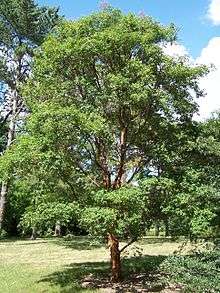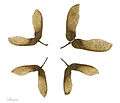Acer griseum
| Paperbark maple | |
|---|---|
 | |
| Acer griseum at the Morton Arboretum Accession 836-58-7 | |
| Scientific classification | |
| Kingdom: | Plantae |
| (unranked): | Angiosperms |
| (unranked): | Eudicots |
| (unranked): | Rosids |
| Order: | Sapindales |
| Family: | Sapindaceae[1] |
| Genus: | Acer |
| Species: | A. griseum |
| Binomial name | |
| Acer griseum (Franch.) Pax 1902 | |
| Wikimedia Commons has media related to Acer griseum. |
Acer griseum (paperbark maple; simplified Chinese: 血皮枫; traditional Chinese: 血皮楓; pinyin: xuè pí fēng) is a species of flowering plant in the family Sapindaceae, native to central China.[2] Acer griseum is found in the Chinese provinces of Gansu, Henan, Hubei, Hunan, Shaanxi, Shanxi and Sichuan, at altitudes of 1,500–2,000 m (4,921–6,562 ft).[2]
Description
It is a small to medium-sized deciduous tree, reaching 6–9 m (20–30 ft) tall and 5–6 m (16–20 ft) wide, with a trunk up to 70 cm (28 in) in circumference.[3] The bark is smooth, shiny orange-red, peeling in thin, papery layers; it may become fissured in old trees. The shoots are densely downy at first, this wearing off by the second or third year and the bark exfoliating by the third or fourth year.[2]
The leaves are compound, with a 2–4 cm petiole with three leaflets, each 3-10 cm long and 2-6 cm broad, dark green above, bright glaucous blue-green beneath, with several blunt teeth on the margins.[2]
The yellow flowers are androdioecious, produced in small pendent corymbs in spring, the fruit being a paired samara with two winged seeds about 1 cm long with a 3 cm wing.[2][4][5][2]
Cultivation and uses
Acer griseum was introduced to cultivation in Europe in 1901 by Ernest Henry Wilson for the Veitch Nurseries, and to North America shortly after. It is one of many species of maples widely grown as ornamental plants in temperate regions. It is admired for its decorative exfoliating bark, translucent pieces of which often stay attached to the branches until worn away. It also has spectacular autumn foliage which can include red, orange and pink tones.
This plant has gained the Royal Horticultural Society's Award of Garden Merit[6]
Recent attempts have been made to acquire new seed stock from wild populations in China because it is believed that the current gene pool of cultivated specimens is very small. Propagation of Acer griseum is somewhat difficult as seeds have the same parthenocarpic tendencies as those of Acer maximowiczianum.[7]
Photo Gallery
-

Trunk (UBC Botanical Garden)
-

Trunk
-

Foliage and immature seeds
-

Foliage and seeds
-

Seeds
-
Bark
-

Bark
-
Bark peeling closeup
-
Bark peeling only on the live branch
References
- ↑ Stevens, P. F. (2001 onwards). Angiosperm Phylogeny Website. Version 9, June 2008 [and more or less continuously updated since]. http://www.mobot.org/MOBOT/research/APweb/.
- 1 2 3 4 5 6 Flora of China (draft): Acer griseum
- ↑ http://www.maple-trees.com/pages/paperbark-maple.php
- ↑ Rushforth, K. (1999). Trees of Britain and Europe. Collins ISBN 0-00-220013-9.
- ↑ RHS A-Z encyclopedia of garden plants. United Kingdom: Dorling Kindersley. 2008. p. 1136. ISBN 1405332964.
- ↑ "RHS Plant Selector - Acer griseum". Retrieved 11 June 2013.
- ↑ van Gelderen, C. J., & van Gelderen, D. M. (1999). Maples for Gardens: A Color Encyclopedia.